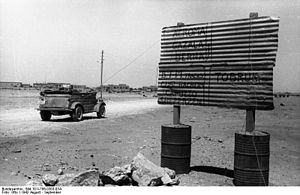Battle of Gazala
Company Theseus
Part of: African campaign (World War II)

Temporary road sign near Tobruk, August 1942.
Major military operations during the African campaign (1940-1943)
1940: Italian invasion of Egypt - Operation Compass1941
: Operation Sunflower - Siege of Tobruk - Operation Battleaxe - Operation Crusader1942: Operation
Theseus - First Battle of El Alamein - Battle of Alam Halfa - Second Battle of El Alamein - Operation Torch1943
: Tunisian Campaign
Unternehmen Theseus (often referred to as the Battle of Gazala) was the cover name of an Axis offensive during the African campaign in World War II. The objective of the military enterprise was to encircle the Allied army dug in between Gazala and Bir Hakeim in fortified positions and to capture the fortress of Tobruk. The successful offensive led to the further advance of the German-Italian troops to El Alamein and thus the furthest eastern advance of the Axis forces in North Africa during the Second World War.
Background
Italy had declared war on France and Great Britain on June 10, 1940. The Italian dictator Benito Mussolini assumed that the war would only be short and hoped to be able to satisfy some of Italy's territorial claims through an alliance with the German Empire. In North Africa these consisted, on the one hand, of an enlargement of the colony of Italian Libya in a westerly direction around the French protectorate of Tunisia. To the east, Italy sought control over Egypt and the strategically important Suez Canal, as well as the establishment of a direct land link to its colonies in East Africa. With France defeated in the Western campaign and Tunisia part of the now allied Vichy France, Italian expansionist aims in North Africa turned entirely to Egypt. On September 9, 1940, Italy finally marched into Egypt with the 10th Army.
Course of the war in North Africa
→ Main article: African campaign
However, the invasion was not very successful and came to a halt only a little more than 100 km behind the Libyan-Egyptian border due to the poor supply and equipment of the troops. On 8 December, the Allies launched a counter-offensive with Operation Compass. Originally limited to only a few days and aimed at driving the Italian army out of Egypt, the operation proved so successful that the advance continued into Libya. By the beginning of February 1941, the Allied troops had occupied the Kyrenaika up to and including El Agheila and had almost completely wiped out the Italian 10th Army.
However, the complete capture of Italian Libya did not take place, since parts of the Allied troops deployed in North Africa were to be used to defend against the German Reich's imminent Balkan campaign in April 1941. Thus, while the Allies withdrew troops to defend Greece beginning in February 1941, Germany simultaneously and secretly shipped the first contingents of troops to Tripoli in what became known as Operation Sunflower and established the German Afrika Korps. Only a few weeks after its arrival, the Afrika Korps commanded by Erwin Rommel, together with the Italian divisions in Libya, went on a renewed offensive. The few and largely inexperienced Allied troops hastily withdrew again from the Kyrenaika.
In the course of April, the Axis forces had again advanced into Egyptian territory as far as the Halfaya Pass. Only the strategically important deep-water port of Tobruk continued to be held by an Allied garrison. After a series of attacks on Tobruk failed in April and early May 1941, Rommel prepared for a prolonged siege of the city to conserve his limited resources. The Allied High Command in the Middle East, under Archibald Wavell, simultaneously began planning and preparing a counteroffensive to regain control of the Cyrenaica and relieve the besieged city. The first counter-offensive - called Operation Brevity - began as early as 15 May, but was able to achieve little more than the recapture of Halfaya Pass (and that only until 27 May). At the same time (from 20 May to 1 June 1941), the airborne battle for Crete was being fought, which, had the German Reich been successful, would have greatly improved Axis air support and supplies. A second Allied offensive launched on 15 June - Operation Battleaxe - failed with heavy tank losses, with Allied forces narrowly escaping encirclement and annihilation. After this failure, Archibald Wavell was replaced as commander-in-chief of the Middle East Command by Claude Auchinleck.
Auchinleck finally succeeded with an offensive launched in November 1941 - called Operation Crusader - to seize the besieged city of Tobruk and bring the entire area up to the Egyptian-Libyan border under Allied control. However, a renewed occupation of the rest of the Cyrenaica failed due to a quickly launched counter-offensive by Rommel, which eventually led to a stalemate at the Allied defensive belt at Gazala in early February. Both sides were too weakened from the previous fighting and respective supply difficulties to launch further attacks. They dug in and refrained from further offensives for the time being.
Search within the encyclopedia